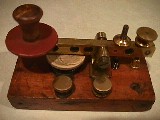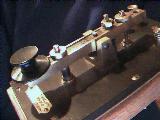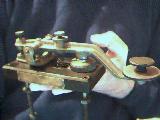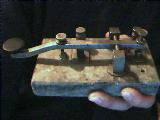Spark Keys 


Just before Horace Martin invented the bug or semiautomatic key, Guglielmo
Marconi, continuing the work of Hertz,
Maxwell, and others invented
wireless radio. Early wireless telegraph, from about 1895 to 1924, was
called "Spark." The spark key was inserted in the high voltage part of
the circuit and sparks literally flew from the key when code was sent.
Spark was initially conceived as a way the Navy could keep in touch with
ships at sea.
Spark also helped keep civilian ships in touch with the shore. The first newspaper ever published aboard ship containing wireless
news from shore was published aboard the St. Paul en route for England on November 15th, 1899.
Landline was then intended to provide the link on the
continent. Spark keys required huge contacts to handle the immense current
and voltage across the contacts. The key shown here is a Wireless Specialty
Apparatus Company spark key with cooling fins on the contacts.

Early wireless radio depended on a spark between brass balls
to generate a transmitting signal. Very high and dangerous voltages
were required. What is the spark voltage between brass balls 2 centimeters in
diameter? It depends on the distance between the balls, the spark length.
Pick a spark length to change the distance between the balls and click on the "Discharge" button to see the voltage
needed to generate a spark. Adapted from Robison's Manual of Radio
Telegraphy and Telephony, 1918, Appendix A, Table 1.
Manufacturers such as the Marconi Company, Machinery Division of the Boston
Navy Yard, Clapp-Eastham, Murdock and many others made spark keys. These
keys tended to be larger and bulkier than the landline telegraph keys of
the time. The key on the left was made by the Marconi Wireless Telegraph
Co., Ltd, of London, England and is a typical World War I instrument.
The center key was made by the Boston Navy Yard and the rating stamped
into the label reads 300 volts at 50 amperes! The key on the right is a
marble-based Clapp-Eastham key made ca. 1915. It is known as the "Boston
Key" and was also available on a bakelite base and with at least 3 different
size contacts.
You can try out a Virtual Spark Transmitter!

The spark key on the left was made by the Wm. J. Murdock Co. of Chelsea,
Mass. There were also offices in Chicago and San Francisco. Murdock
also sold other radio gear in addition to spark keys.

The spark key on
the right is another Boston Navy Yard model, with the contacts encased in solid metal. This presumably
protected it from its surroundings.

As early as 1901, the U.S. Navy was considering buying equipment from
Marconi, Ducretet, Rochefort, Slaby-Arco, and Braun-Siemens. Ducretet and
Roger, of Paris, France, sold the U.S. Navy two complete wireless
sets in 1902 for $2,614.37. This Ducretet
and Roger aircraft oil break key dates to about 1915. It represents the
merging of two technologies in their infancy: airplanes and wireless. The
contacts are submerged in oil to prevent the spark from igniting the
gasoline fumes in the early airplanes.
The semiautomatic key invented by Horace Martin could not handle the
large currents associated with spark telegraphy. Building on the Fleming
Valve, or diode, of the 19th century, Lee De Forest invented the Audion
tube, or triode. The Audion was capable of undamped oscillation and
allowed the development of continuous wave wireless (CW.) The semiautomatic key
or bug now could evolve into the most popular telegraph instrument of the
mid 20th century.


Electro-Magnetic Induction
As a magnet enters a coil of wire, an electromotive force is induced
in the coil of wire. If there is a complete circuit, a current of electricity
will flow. This effect is known as Electro-magnetic Induction. As the
magnet is moved into the coil, the needle of the galvanometer is deflected
indicating that a current of electricity has been generated in the coil.
If we withdraw the magnet from the coil, the needle of the galvanometer will
again be deflected, this time in the opposite direction. Adapted from
"The Elementary Principles of Wireless Telegraphy", by R.D. Bangay.

A Comprehensive Listing of Spark Key Manufacturers
With Locations, Dates, Comments and Links to Pictures

 Back to the index
Back to the index
 On to the Vibroplex line
On to the Vibroplex line















 Back to the index
Back to the index
 On to the Vibroplex line
On to the Vibroplex line